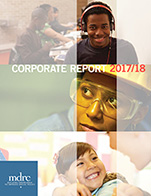MDRC’s New Corporate Report Highlights Recent Successes, Future Directions
 Every other year, MDRC publishes a corporate report that highlights what we’re doing to accomplish our mission of finding solutions to some of the most difficult problems facing the nation — from reducing poverty and bolstering economic self-sufficiency to improving public education and college graduation rates.
Every other year, MDRC publishes a corporate report that highlights what we’re doing to accomplish our mission of finding solutions to some of the most difficult problems facing the nation — from reducing poverty and bolstering economic self-sufficiency to improving public education and college graduation rates.
As MDRC President Gordon Berlin writes in our new corporate report:
If they are to improve the lives of low-income Americans, programs must actually work. To know which ones work, we need reliable evidence. It can sometimes be difficult to act on that evidence. But we have made good progress over the years in identifying programs and policies that do make a difference.
The next challenge, though, is to learn to successfully expand effective programs….One important warning sign is that efforts to replicate promising findings often disappoint. Why? It is frequently assumed that the replication failed to implement the model properly; indeed, maintaining “fidelity” to a model can be a challenge as a program expands. But context can also matter. When programs expand, they have to adapt. They must serve new populations that may be demographically and culturally different, and they must operate in new local systems with different policies, procedures, and service networks. They may also face new challenges simply because the fundamental nature of a problem changes over time. For example, early childhood home-visiting programs to strengthen parenting are well supported by evidence, but when they began, opioid use was not the crisis in America that it is today.
To help the field adapt, the way we approach evidence building and the tools we use must change. Over the last five years we have been hard at work making those kinds of changes at MDRC. Recognizing that many of the nation’s programs and services are delivered by nonprofit organizations or by state and local governments, we have used our research and practice expertise to develop tools to help those entities reliably evaluate programs’ effectiveness, use what is learned to identify strengths and weaknesses, and apply that information to improve performance.
We have developed low-cost behavioral science techniques, for example, that can be used to diagnose obstacles to participant recruitment and engagement so that programs can address them. We are using predictive analytics to help programs improve their targeting and more clearly estimate participants’ risk of not meeting their goals. We are using our experience won from years of research and on-the-ground work to help organizations create databases to track services and outcomes. We have also increased the sophistication of our implementation research, leading to better information about how programs are making a difference, for whom, and why.
The objective is to use all of this information to help programs and governments become learning organizations capable of adapting and tailoring existing services and spurring the development of new implementation strategies or program components…..





